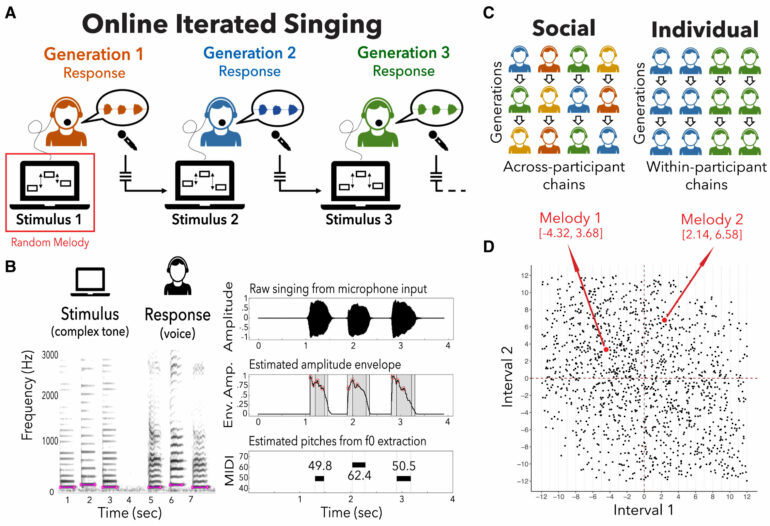Whether it is folk songs, lullabies, or ballads, music has been transmitted orally for countless human generations. In the largest ever cultural transmission study on the evolution of music, an international research team from the Max Planck Institute for Empirical Aesthetics (MPIEA) in Frankfurt am Main, Germany, the University of Oxford, and the University of Cambridge has analyzed how human songs change over time under the influence of social, cultural, and cognitive factors.
The results have just been published in the journal Current Biology.
The researchers used singing experiments to study music evolution in an unprecedented detail: testing the evolution of more than 3,400 melodies sung by around 1,800 participants from India and North America. To simulate music evolution, they used a method similar to the classic game of “broken telephone,” where messages are passed from one participant to the next.
In this case, melodies had to be passed from one to the next by singing. Over time, participants make mistakes in their efforts to repeat the melodies they hear, which gradually shapes the evolution of music towards melodies that are appealing and easy to learn by everyone.
“For most of our history, oral transmission was the main mechanism by which songs were passed down human generations. We believe that cross-cultural commonalities and diversities in human song emerged from this process of ‘cultural transmission,’ but thus far it has been difficult to test how cultural transmission shapes music evolution,” says first author Manuel Anglada-Tort from the MPIEA.
The researchers found that oral transmission has profound effects on music evolution, revealing the emergence of diverse musical structures. Some of these structures were shared across cultures, such as small pitch intervals or arch-shaped melodic contours (melodies that go up in pitch and then go down).
Senior author Nori Jacoby from the MPIEA explains, “In several controlled experiments, we found that this happened because humans share similar transmission biases for music, such as those imposed by biological and cognitive factors. For example, musical elements that are difficult to sing, such as large pitch intervals, or remember, such as unfamiliar melodies, are less likely to survive the transmission process.”
However, the study also found important cross-cultural differences in evolving melodies. US participants tended to produce melodies that were biased towards certain cultural conventions of Western music, whereas Indian participants showed a bias towards common Indian scales.
This suggest that cultural exposure is also an important factor determining music evolution. Overall, these results show that human transmission biases—biological, cognitive, and cultural—are a bottleneck for evolution by oral transmission. It is possible that similar constraints played a role in shaping the evolution of music by early humans.
Finally, the researchers found that cultural transmission can further amplify biases for music that are shared by most individuals within a group. This explains why certain musical structures spread faster and become more popular over time. More importantly, this also explains why we observe large cross-cultural differences in the music produced in different groups.
These results provide a new understanding of how cross-cultural differences and similarities in human song can emerge via cultural transmission. The implications of this study may extend beyond music to other behaviors that result from cultural transmission, such as human language or social norms.
More information:
Manuel Anglada-Tort et al, Large-scale iterated singing experiments reveal oral transmission mechanisms underlying music evolution, Current Biology (2023). DOI: 10.1016/j.cub.2023.02.070
Provided by
Max Planck Society
Citation:
New research shows how cultural transmission shapes the evolution of music (2023, March 22)
